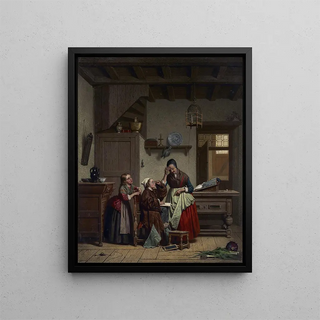Art print | Children's game - Claude Joseph Vernet


View from behind

Frame (optional)
Art print for children’s play - Claude Joseph Vernet – Captivating introduction
In the enchanting universe of art, some works manage to capture the innocence and joy of childhood with such intensity that they remain etched in the collective memory. "Children’s Play" by Claude Joseph Vernet is a perfect example. This canvas, imbued with delicacy and vibrancy, transports us to a world where the lightness of children's games intertwines with the beauty of an idyllic landscape. Vernet, known for his marine landscapes and scenes of everyday life, succeeds here in immortalizing a moment of pure happiness. The work not only evokes the lightness of childhood but also offers a reflection on the passage of time, on those fleeting moments that we will always cherish.
Style and uniqueness of the work
Vernet’s style is distinguished by his meticulous attention to detail and his ability to play with light. In "Children’s Play", the characters, though small, are depicted with such precision that they seem almost alive. The vibrant colors, ranging from the bright greens of the trees to the soothing blues of the sky, create an atmosphere of serenity and happiness. The composition is skillfully orchestrated, each element finding its place in a harmonious balance. The children, at the center of the scene, are surrounded by a natural setting that emphasizes the simplicity and beauty of their game. Vernet manages to evoke a sense of nostalgia, reminding each of us of the simple pleasures of our own childhood.
The artist and his influence
Claude Joseph Vernet, born in 1714, was a French painter whose work profoundly marked the 18th century. His ability to capture nature and depict scenes of everyday life earned him international recognition. Vernet was a pioneer in landscape art, influencing many artists who followed him. His innovative approach and distinctive style paved the way for a new way of perceiving the landscape, not only as a background but as a true actor in storytelling. Through "Children’s Play", Vernet demonstrates his skill in merging realism with a poetic touch, creating a work that transcends time and continues to

Matte finish

View from behind

Frame (optional)
Art print for children’s play - Claude Joseph Vernet – Captivating introduction
In the enchanting universe of art, some works manage to capture the innocence and joy of childhood with such intensity that they remain etched in the collective memory. "Children’s Play" by Claude Joseph Vernet is a perfect example. This canvas, imbued with delicacy and vibrancy, transports us to a world where the lightness of children's games intertwines with the beauty of an idyllic landscape. Vernet, known for his marine landscapes and scenes of everyday life, succeeds here in immortalizing a moment of pure happiness. The work not only evokes the lightness of childhood but also offers a reflection on the passage of time, on those fleeting moments that we will always cherish.
Style and uniqueness of the work
Vernet’s style is distinguished by his meticulous attention to detail and his ability to play with light. In "Children’s Play", the characters, though small, are depicted with such precision that they seem almost alive. The vibrant colors, ranging from the bright greens of the trees to the soothing blues of the sky, create an atmosphere of serenity and happiness. The composition is skillfully orchestrated, each element finding its place in a harmonious balance. The children, at the center of the scene, are surrounded by a natural setting that emphasizes the simplicity and beauty of their game. Vernet manages to evoke a sense of nostalgia, reminding each of us of the simple pleasures of our own childhood.
The artist and his influence
Claude Joseph Vernet, born in 1714, was a French painter whose work profoundly marked the 18th century. His ability to capture nature and depict scenes of everyday life earned him international recognition. Vernet was a pioneer in landscape art, influencing many artists who followed him. His innovative approach and distinctive style paved the way for a new way of perceiving the landscape, not only as a background but as a true actor in storytelling. Through "Children’s Play", Vernet demonstrates his skill in merging realism with a poetic touch, creating a work that transcends time and continues to






